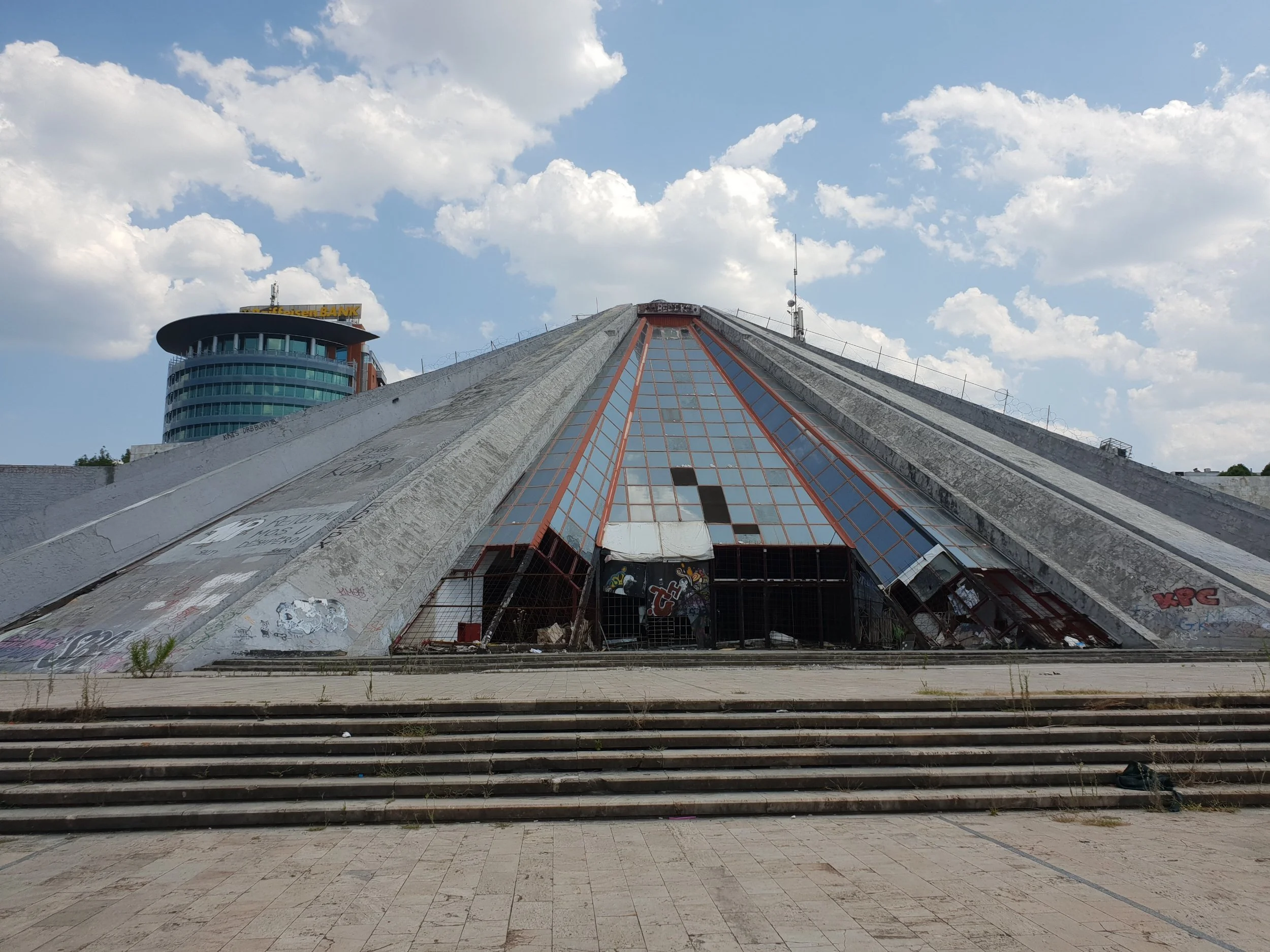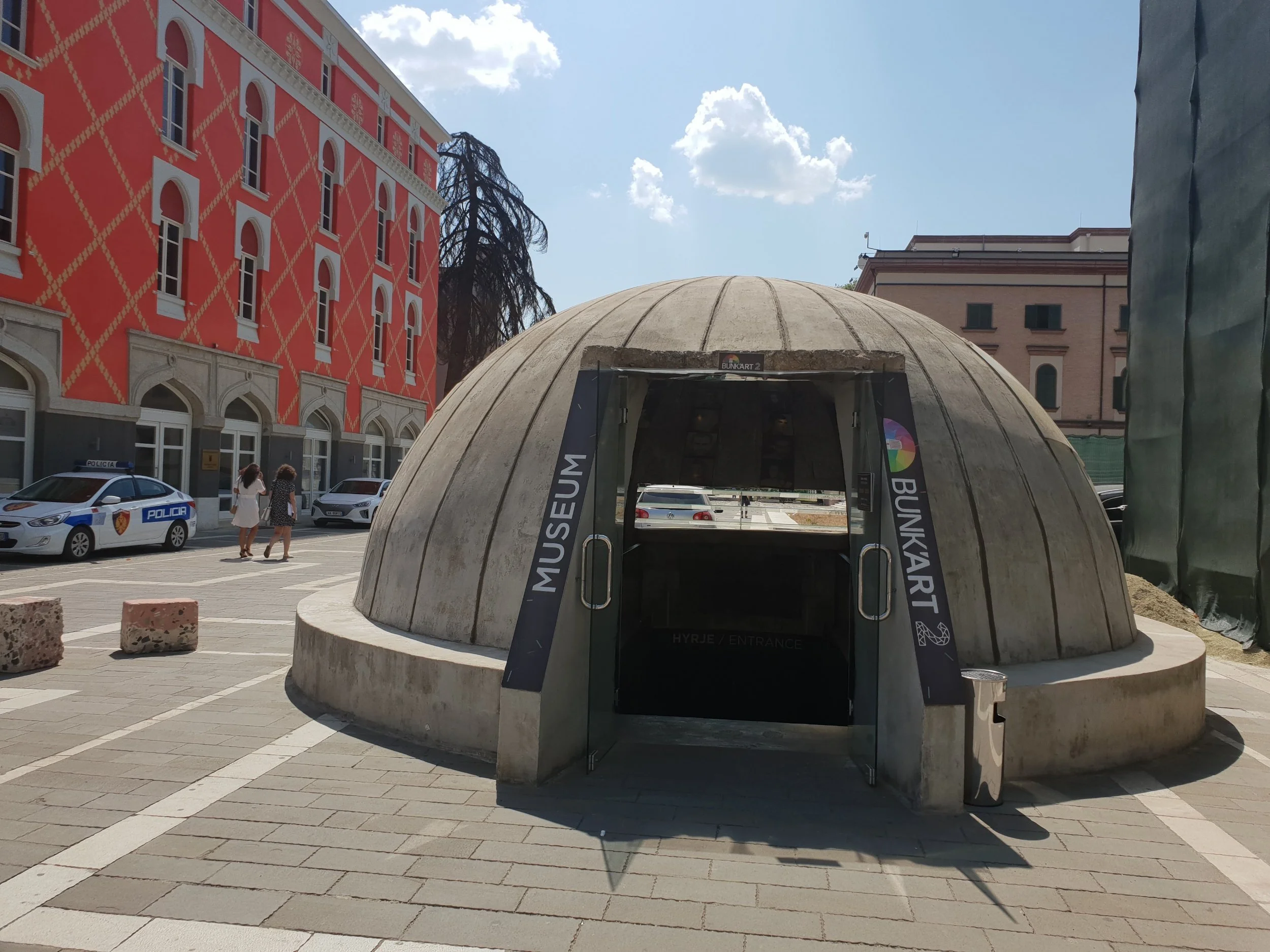Albania Top 10
1. Tirana street art murals and festival
In 2018, the Albanian capital of Tirana hosted the first edition of MurAL Festival, a huge event where local and international artists left their arty mark on buildings around the city. The festival focussed on the interest in street art and created energy throughout many public spaces in the city. The capital is alive with murals, the Rainbow in Wilson Square seen as one of the most famous - adding colour to an area once grey and grimy. As a result of the festival, alongside the encouragement from the art educated prime minister, once the Mayor of Tirana, you will find arty surprises all around the city. Look out for the normally dull and blank electricity boxes found on pavements. Now infused with portraits of batman and Salvador Dali.
2. Tirana Pyramid
The number one tourist attraction in Tirana is a sight to behold. A symbolic landmark of the capital, the Pyramid of Tirana is a relic portraying a turbulent past Allegedly, the most expensive ever erected building in Albania. Originally designed as a museum for Enver Hoxha, Albania’s Communist leader the brainchild of a team including Hoxha’s daughter Pranvera Hoxha. The Pyramid initially opened in 1988, exactly three years after the death of Enver Hoxha, as a posthumous dedication to him. Communism fell shortly after and the Pyramid faced radical changes to its purpose and role in the city of Tirana.
In 1991 however, the building became a conference centre and its social role slowly faded away. In 1999, the Pyramid took on more of a humanitarian function as NATO set up their headquarters for the duration of the war in Kosovo. In 2001, the primary TV channel (TOP Channel) set up temporary headquarters inside the Pyramid. The Pyramid now lies derelict, fenced off and now home to graffiti. At one point locals and tourists would climb to the top and slide down, like a giant Pyramid slide.
3. Albania Fjord at Lake Koman
You may be surprised to find fjords on the Albania hidden gems list. Scandinavian take note, you have some fjord competition. The spectacular Lake Koman is the gateway to this epic discovery in the northern part of the country. The lake, a reservoir in the Drin River stretches for an area of 34 square kilometres, from Koman Village to Fierzë Village.
The mostly narrow lake is nestled among the mountains of the Shkodra and Kukës regions. Koman Lake should be added to the list. The cross-lake trip from Koman to Fierza lasts for less than three hours and is hailed as one of the top travel experiences in Albania! The ferry ride offers spectacular panoramic views of the untouched landscape surrounding the lake. At times narrow and surrounded by canyons and at others wide and sprawling, the view from the ferry keeps you wanting more as you explore this nature-filled gem.
4. Albanian Riviera - Ksamil
Ksamil Beach with the cobalt blue waters is the dream spot on the Albanian Riveria. The coastline, blessed with dozens of pretty cove beaches and three small, dreamy islands within swimming distance of shore.
The locals enjoy the white sand beaches, peddle boats designed as taxis for hire to navigate the wavy waters or a swim out to the small islands. With restaurants dotted around the sand dune cove beaches, this is the picture-perfect day trip location found south of the main beach town, Sarande.
5. Albanian Riviera - Sarande
Sarandë is a resort on the Albanian Riviera, in southern Albania. Sandwiched between the Ionian Sea and hills of olive groves, the town is on a horseshoe-shaped bay, edged by beaches and a promenade. This is where the locals and tourists come in the hot summer months to escape and enjoy the sea breeze. The busy nightlife and promenade have something for everyone – whether day or night. The promenade is filled with restaurants, bars, ice cream parlours, night markets, nightclubs and white sandy beaches to enjoy. It still has a fishing village vibe but now the original village is enveloped by the modern thriving city.
This is the perfect base to explore Butrint and the other beaches dotted around the Albanian Riveria.
6. Butrint
Butrint is an archaeological national park in Albania and a UNESCO World Heritage site since 1992, renowned for its ancient ruins dating back as far as the 7th century BC. 20km South of the main resort town of Sarande, Butrint has been the site of a Greek colony, a Roman city and a bishopric. Following a period of growth under Byzantine rule, then a brief occupation by the Venetians, the city was abandoned in the late Middle Ages after marshes formed in the area. The present archaeological site is a collection of ruins representing each period in the city’s development.
As a result, Butrint offers a wealth of incredible archaeological structures, including a well preserved Greek theatre, fortifications that have been changed by each civilisation that occupied it, Roman public baths inside which lies a paleo-Christian baptistery and a 9th century basilica.
One of Butrint’s earliest sites is its sanctuary, which dates back to the fourth century and sits on its hill or “acropolis”. The sanctuary was named after the Greek god of medicine, Asclepius, and was a centre of healing.
7. Berat
Berat’s most striking feature is the collection of white Ottoman houses climbing up the hill to its castle, earning it the title of 'town of a thousand windows'. It joined Gjirokastra on the list of UNESCO World Heritage sites in 2008. Its rugged mountain setting looks picture perfect as you glance back to the town built into the side of the mountain from the main bridge.
Berat has managed to retain its easy-going charm and friendly atmosphere it is worth adding it to your list. With cobble streets, authentic restaurants, and an impressive new hotel in the home of the previous university – a building with a dome roof seen from the fortress.
It is worth a day trip to experience the Ottoman style buildings dotted about the old town and make sure you make the steep climb to the castle to enjoy the sunset and all the views back out to the valley. There is also an arty ‘I LOVE BERAT’ sign painted on one of the cobbled backstreets - if you are game to find it.
8. Albanian Alps
The Albanian Alps lie in the Northern part of the country found in the National Parks of Thethi, Valbona and the Region of Kelmendi. They are truly spectacular. The mountains spread over the borders of Albania, Kosovo and Montenegro, and in Albania they reach a respectable height of 2694m. A national park of 8,000 hectares, it is one of the most beautiful natural areas in Albania.
This spring rushes through limestone fissures on its way to the Valbona River creating an attractive canyon, 2-3 m wide and 50 m deep. After entering the valley, you will pass several picturesque villages. The first, with alpine-style houses, is called Dragobia, and it is where the valley narrows. Past Dragobia, at the foot of the mountain where the Cerremi stream joins the Valbona River, is the famous cave where the national hero Bajram Curri was besieged and killed. The Albania Alps, alongside the fjord at Lake Koman is the nature, adventure seekers dream destination.
9. Gjirokastra
Gjirokastra is a magical hillside town renowned for its fortress, roads paved with chunky limestone, imposing slate-roofed houses and views out to the Drina Valley. There has been a settlement here for 2500 years, though these days it's the 600 'monumental' Ottoman-era houses in town that attract visitors.
UNESCO World Heritage Site, described as "a rare example of a well-preserved Ottoman town, built by farmers of large estate". For Albanians, the town is also synonymous with Albania's most famous author, Ismail Kadare (b 1936) as the town is featured in his book Chronicle in Stone. There is a leisurely hike out to the valley to see the ruins of the Ali Pasha bridge, part of the once-impressive aqueduct built to channel water to Gjirokaster castle’s cisterns from mountain springs 10km away.
10. Tirana Bunk’rt Museums
There are over 750,000 bunkers around the country, built to protect the country from the attack the paranoid communist leader Enver Hoxha convinced would come. None ever used! Most now remain as lasting memories of these crazy times. There are two famous sites - Bunk’Art 1 & 2. Bunk’Art 1 opened in 2014. The underground bunker, built as a shelter for Hoxha and his government in case of a nuclear attack, was never used for its intended purpose as no such attack ever came to pass. Its construction commenced in 1978 but, with Hoxha’s death in 1985 halting all work towards its completion, the bunker was left in waiting, missing both an entrance and an exit.
After the completion in 2014, the bunker was transformed into a historical museum and art gallery, now known as Bunk’Art. The bunker runs five stories beneath the surface of Tirana and boasts a total of 106 rooms. Bunk’Art 2 museum and art space reflects Tirana’s initiative to use culture to celebrate the birth of a new era, whilst remembering its solemn past.
The unearthing of this underground tunnel in the center of Tirana, echoes the uncovering of ancient ruins in any of the world’s most fascinating historical cities. Located on the main block of ministerial buildings in the city’s center, this underground shelter was hidden from the public eye until to its recent unveiling in 2015. Secretly built from 1981-86. Each of its 24 rooms recount stories of the political persecutions during Communism, and exhibitions showing the state’s means of persecution during this dark period of history.
The exhibition sends chills down your spine with stories and photos across the 40 years. The Primo Levi quote grabs your attention above the entrance - ‘All Those Who Forget There Past Are Condemned to Relive it’.







